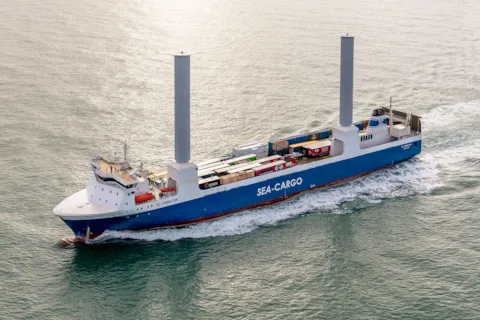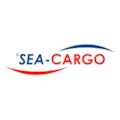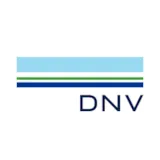Get regular maritime industry insights!
Join more than 70.000 of industry insiders today who have already signed up to receive the latest insights.
Sign up
In 2021 two tiltable Norsepower rotor sails, certified by DNV, were retrofitted on board SC Connector, a Sea-Cargo Ro-Ro vessel operating in the North Sea. Captain Artur Sylwestrzak gives a compelling account of the before and after.


Captain Artur Sylwestrzak graduated from the Maritime University in Gdynia, Poland. A passionate scuba diver and sailor, he has been sailing on tall ships since he was 12 years old. He later gained professional experience on board Zawisza Czarny, Fryderyk Chopin and Dar Młodzieży and participated in various regattas. He started working at Sea-Cargo as a junior officer and has been captain of SC Connector since 2020.
What were your first impressions after the rotor sails were installed on SC Connector?

I had an idea what to expect, and I had personal sailing experience, including tall ships. I was captain of SC Connector before the rotor sails were installed and knew the ship. But I was surprised how much its behaviour changed. Before the rotor sails were retrofitted, I often had to wait in port for better weather. The rotor sails have improved the ship’s seakeeping behaviour very much – it is a completely different vessel now! The centre of gravity has been raised by one and a half metres, and the rotor sails dampen the roll motion so the ship hardly rolls at all, which the crew are very happy about. Norsepower were really impressed by the force generated by the rotor sails.

How do the rotor sails affect the operation of the ship?

In adverse weather there is a constant list, sometimes as much as 12 degrees. We take the waves from the side, keep the fins out, and once I have the wind from the side, I am able to create an enormous force ahead. With sufficient wind, the ship can maintain its speed without needing help from the propeller. However, we need to keep the main engine running to create enough flow to the rudder, otherwise we lose control of steering. Of course, the rules of the game have changed with rotor sails: we no longer sail the shortest route. I change my route every six to seven hours to adapt to the current conditions and the weather forecast. Extending the route means I have to compensate by gaining extra speed from the rotor sails.

What are the operational limits for the rotor sails on your vessel?

The inherent limitation of the rotor sail is the dead angle in headwind of about plus/minus 20 degrees where the rotor sails don’t generate enough forward force but mainly lateral force. We have to set the course so that the wind comes from the side, between 70 and 110 degrees. Together with Norsepower, we had initially set relatively low maximum apparent wind speed and force limits. After we collected some experience and they inspected the system, it was decided to increase the limits to be able to operate in adverse weather conditions. Even when we are not generating any forward force, we keep the rotors running to stabilize the vessel using the lateral forces. I normally stay in port at very high wind speeds, but when we run into unexpected adverse weather in the middle of the North Sea, the raised limit allows me to keep the rotor sails running, travel faster and have better control.

How important is personal commitment for successful operation of rotor sails?

It is a huge benefit when the crew have an interest in this technology and are motivated to learn. I always try to create an environment that will motivate new people and make them curious. I invite them to get involved, saying “let’s play with the system and see what we can learn in the process.” This approach is much more enjoyable to newcomers. We are also trying to further automate the system so it will require less human interaction.

Do rotor sails require specific crew training?

To draw the greatest benefit from the system, you need to provide training so the crew fully understand the physics behind it all, and how the ship responds. We have to make at least two passages on the open sea under suitable wind conditions to make a new captain understand how to operate it, and what to do in certain critical situations.

How do the rotor sails affect your timing?

The rotor sails are a key aspect for our timing. We operate on a fixed schedule. I can only influence the length of my route and the speed. In one instance I had to sail around some very bad weather. Although I extended my route by some 80 miles, I was able to arrive on time, with a very large portion of my propulsion energy coming from the wind.

Join more than 70.000 of industry insiders today who have already signed up to receive the latest insights.
Sign up